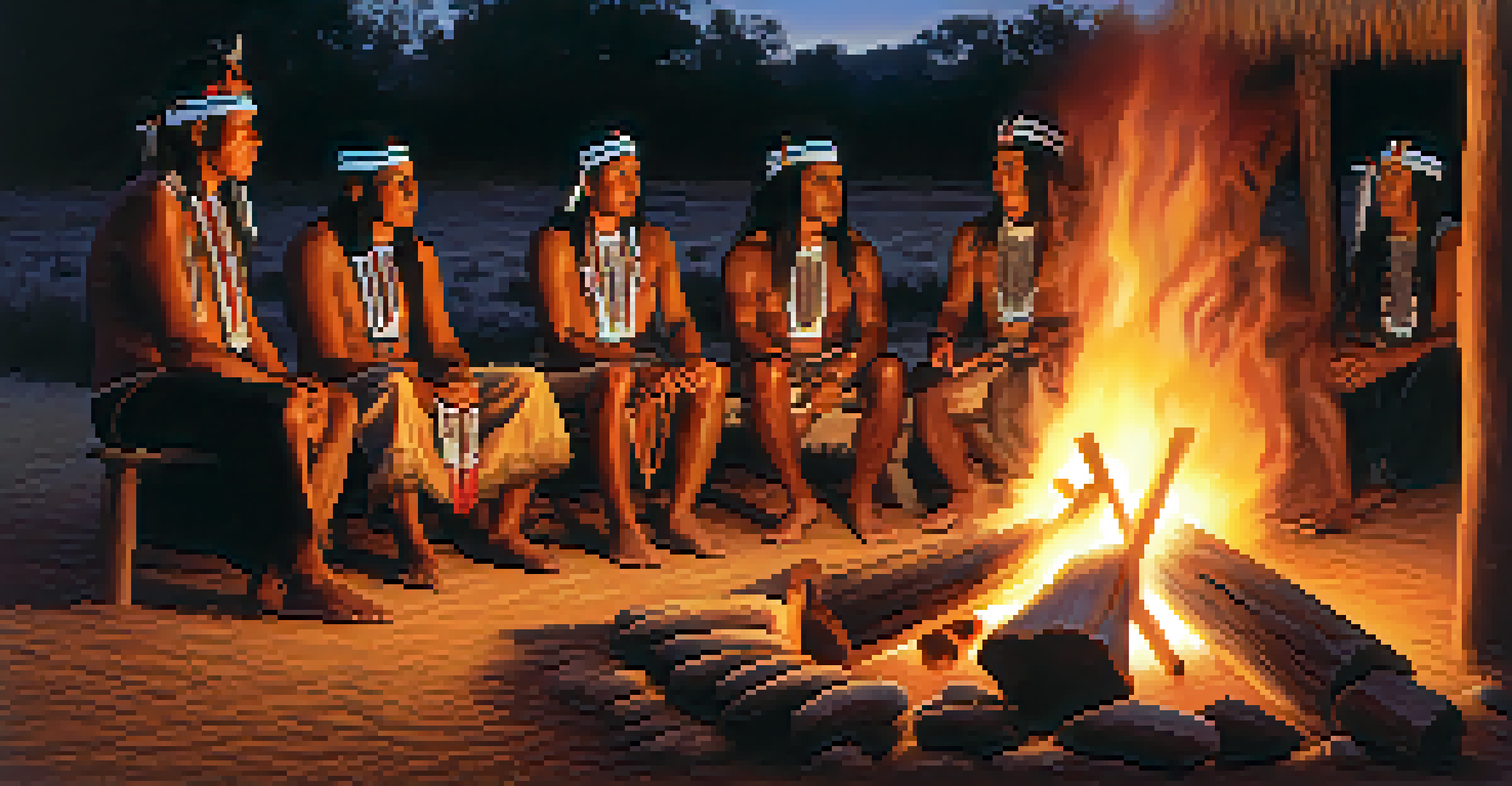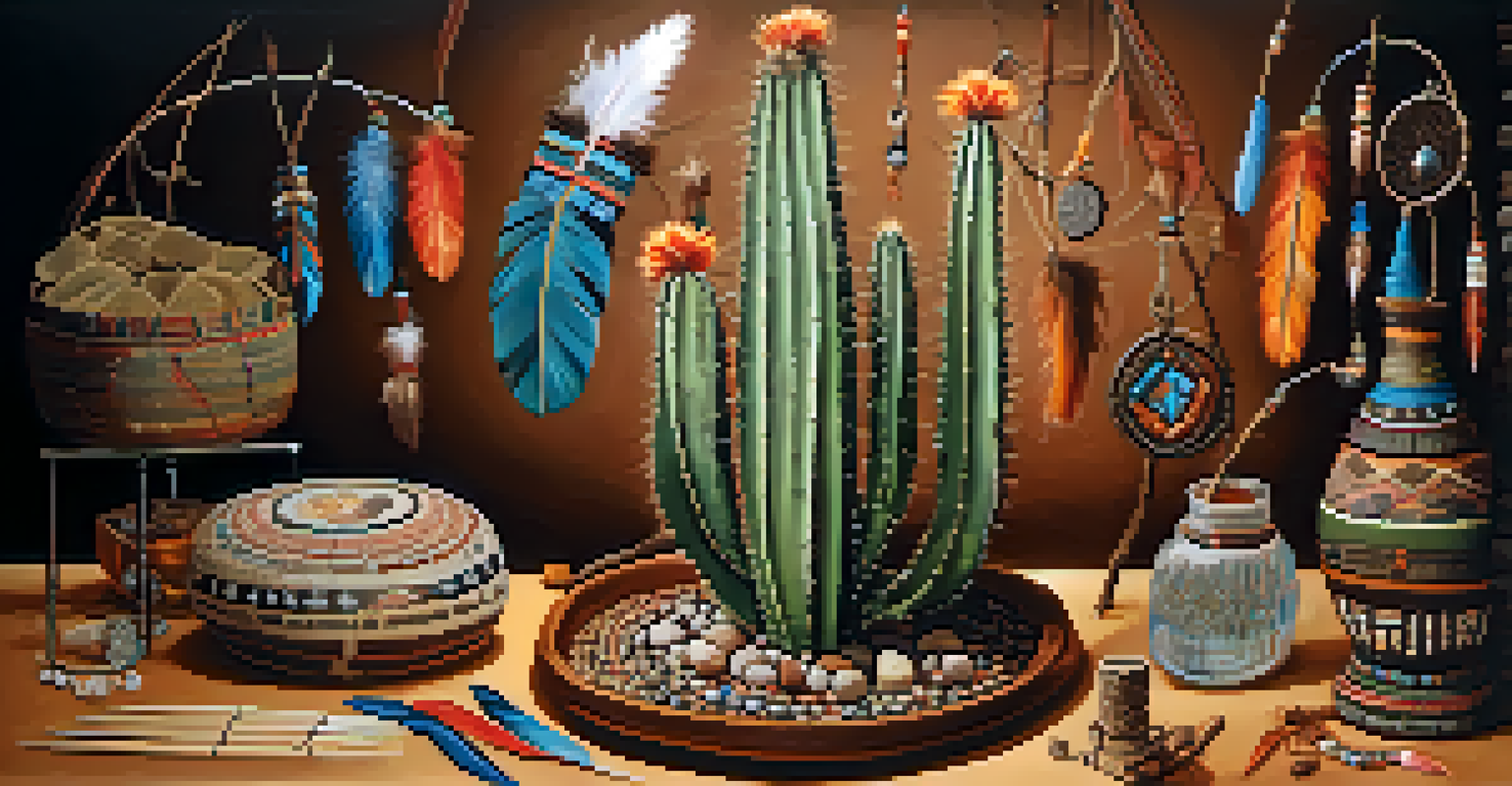Cultural Significance of Peyote in Native American Traditions

Understanding Peyote: A Sacred Plant in Native Cultures
Peyote, a small cactus native to the southwestern United States and Mexico, holds immense spiritual significance for many Native American tribes. This unique plant contains mescaline, a psychoactive compound that has been used for centuries in religious and healing ceremonies. For these communities, peyote isn't just a plant; it's a conduit to the divine, facilitating spiritual connection and insight.
The use of peyote is a way of connecting to the sacred, to the spirit world, and to our ancestors.
The use of peyote dates back over 5,000 years, illustrating its long-standing importance in indigenous cultures. Tribes such as the Huichol and the Lakota have woven its use into their spiritual practices, emphasizing its role in rituals designed to connect with ancestors and the spirit world. Understanding peyote's place in these traditions requires recognizing its cultural, historical, and spiritual layers.
In many Native American belief systems, peyote is viewed as a gift from the Creator, intended to aid humans in their journey through life. This perception fosters a deep sense of respect and responsibility among those who partake in its use, ensuring that ceremonies are conducted with reverence and care.
Peyote in Traditional Ceremonies and Healing Practices
Ceremonies involving peyote often serve multiple purposes, including healing, personal introspection, and community bonding. During these gatherings, participants consume peyote in a controlled setting, guided by experienced leaders known as 'roadmen' or 'shamans.' These leaders play a crucial role in creating a safe environment for spiritual exploration.

One common ceremony is the Native American Church service, which blends traditional practices with Christian elements. Participants come together to sing, pray, and share their experiences while under the influence of peyote. This communal aspect not only strengthens individual spiritual journeys but also reinforces community ties, promoting a sense of belonging and shared purpose.
Peyote's Spiritual Significance
Peyote is revered by Native American tribes as a sacred plant that facilitates spiritual connection and insight.
Peyote is also used for healing physical and emotional ailments, with many individuals reporting transformative experiences that lead to improved mental health. The introspective nature of peyote journeys can help individuals confront personal challenges, gain clarity, and foster emotional resilience.
The Role of Peyote in Identity and Community
For many Native American tribes, peyote represents a vital aspect of cultural identity. The rituals surrounding its use are not merely spiritual acts; they are also expressions of cultural heritage and resilience. Engaging with peyote allows individuals to connect with their ancestors and uphold traditions that have been passed down through generations.
Peyote is not just a plant; it is a symbol of our identity and a pathway to healing and cultural resilience.
The practice of using peyote has also become a form of resistance against historical injustices faced by indigenous peoples. As tribes navigate the complexities of contemporary life, peyote ceremonies serve as a reminder of their roots and the importance of preserving their cultural practices. This reclamation of identity fosters pride and unity within communities.
Additionally, the shared experiences during peyote ceremonies strengthen social bonds among participants, reinforcing a collective identity. Through these gatherings, individuals find support and understanding, creating a nurturing environment that promotes personal and communal growth.
Legal and Societal Challenges Surrounding Peyote Use
Despite its cultural significance, the use of peyote is not without controversy. Legal restrictions have posed challenges for Native American tribes seeking to maintain their traditional practices. The Controlled Substances Act classifies peyote as a Schedule I drug, complicating its use in non-religious contexts.
However, the American Indian Religious Freedom Act (AIRFA) provides some legal protections for the use of peyote in religious ceremonies. This legislation acknowledges the importance of peyote in Native American spirituality, allowing tribes to engage in their traditional practices without fear of legal repercussions. Yet, the ongoing struggle for recognition and rights continues.
Cultural Identity and Resilience
The use of peyote is a vital expression of cultural heritage for many tribes, reinforcing their identity and community bonds.
As awareness around the cultural importance of peyote grows, advocates are pushing for more comprehensive legal protections. This ongoing dialogue highlights the need for a nuanced understanding of indigenous rights and the significance of peyote in the context of cultural survival.
Peyote and the Modern Native American Experience
In today's world, many Native Americans face the challenge of balancing modern life with their cultural traditions. Peyote ceremonies offer a way to reconnect with heritage, providing a space for individuals to explore their identity amidst the complexities of contemporary society. This blend of old and new is essential for preserving cultural practices.
For younger generations, peyote serves as a bridge to their ancestors, fostering a sense of belonging and cultural pride. Many young Native Americans actively seek out peyote ceremonies as a means of understanding their roots and reinforcing their connection to the land and their community. This resurgence of interest highlights the enduring relevance of peyote in shaping identity.
Moreover, the use of peyote in modern contexts often emphasizes its therapeutic potential, with many individuals finding solace and healing through these experiences. As mental health awareness grows, the role of peyote as a tool for personal growth and community support becomes increasingly recognized.
Cultural Misunderstandings and Appropriation of Peyote
As interest in peyote has grown outside Native American communities, cultural misunderstandings and appropriation have become pressing concerns. Many non-Native individuals seek out peyote experiences without understanding the cultural significance behind them. This can lead to a commodification of sacred practices, stripping them of their meaning.
Cultural appropriation occurs when elements of one culture are taken and used by another, often without permission or understanding. This is particularly problematic when it comes to sacred traditions like peyote ceremonies, as it can diminish their significance and exploit indigenous cultures. It's essential for outsiders to approach such practices with respect and awareness.
Legal Challenges and Advocacy
Despite its cultural importance, peyote faces legal restrictions, prompting ongoing advocacy for recognition and protection of its use in traditional practices.
Engaging with Native American traditions requires a commitment to listening and learning from those communities. It’s crucial for individuals to understand the rich history and significance of peyote before participating in its use, fostering a respectful dialogue that honors its cultural roots.
The Future of Peyote in Native American Traditions
Looking ahead, the future of peyote in Native American traditions hinges on a combination of legal recognition, cultural preservation, and community resilience. Ongoing advocacy efforts aim to secure protections for peyote use, ensuring that future generations can engage with this sacred plant in their spiritual practices.
Education and awareness are key components in shaping a positive future for peyote. By fostering understanding among both indigenous and non-indigenous communities, there is potential for greater respect and support for Native American traditions. This mutual respect can lead to a more inclusive dialogue around peyote and its significance.

Ultimately, the survival of peyote traditions relies on the commitment of Native American communities to uphold their cultural practices while navigating the challenges of modern society. As they continue to celebrate and honor peyote, its role as a sacred plant will remain a vital part of their identity and spiritual journey.